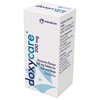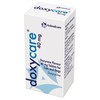Doxycare
Doxycare Flavoured Tablets are for the treatment of bacterial respiratory tract infections in cats and dogs, due to organisms sensitive to doxycycline including: Staphylococcus aureus and other Staphylococcus spp., Streptococcus spp., Bordetella bronchiseptica, and Pasteurella spp. They can also be used for the treatment of tick borne Ehrlichia canis infection in dogs.
Doxycare Flavoured Tablets are yellowish, round and convex tablets with a cross-shaped break line on one side. They can be divided into 2 or 4 equal parts for easy and accurate dosing.
Doxycare 200mg Flavoured Tablets for Cats and Dogs
£1.75Doxycare 200mg Flavoured Tablets are indicated for the treatment of bacterial respiratory tract infections in cats and dogs, due to organisms sensitive to doxycycline Doxycare is also for...[More info]
Doxycare 40mg Flavoured Tablets for Cats and Dogs
£0.70Doxycare 40mg Flavoured Tablets are indicated for the treatment of bacterial respiratory tract infections in cats and dogs, due to organisms sensitive to doxycycline Doxycare is also for...[More info]
Contraindications
Do not use in cases of hypersensitivity to the active substance, to other tetracyclines or to any of the excipients.
Do not use in cases of dysphagia or diseases accompanied by vomiting.
Do not use in cases of vomiting, oesophagitis and oesophageal ulcerations see section adverse reaction.
Special warnings for each target species
Canine ehrlichiosis: the treatment should be initiated as soon as the occurrence of 1st clinical signs. The dog can remain a carrier of the bacteria even after prolonged antibiotic treatments and can be the source of new tick infestations (disease's vector)
Special precautions for use
Special precautions for use in animals
Do not exceed the recommended dosage.
As tablets are flavoured store tablets out of reach of the animals in order to avoid accidental ingestion.
Due to the likely variability (time, geographical) in the occurrence of resistance of bacteria for doxycycline, bacteriological sampling and susceptibility testing are recommended. Official, national and regional antimicrobial policies should be taken into account when the product is used. Use of the product deviating from the instructions given in the SPC may increase the prevalence of bacteria resistant to doxycycline and may decrease the effectiveness of treatment with other tetracyclines, due to the potential for cross-resistance.
In order to reduce the likelihood of oesophageal irritation as well as other gastrointestinal side effects, such as vomiting, the product should be administered together with food.
Special care should be taken when administering the product to animals with liver disease, since increases in hepatic enzymes have been documented in some animals after doxycycline treatment.
The product should be administered with caution to young animals, since tetracyclines as a class may cause permanent discolouration of the teeth, when administered during tooth development. However, human literature indicates that doxycycline is less likely than other tetracyclines to cause these abnormalities, due to its reduced ability to chelate calcium.
Special precautions to be taken by the person administering the veterinary medicinal product to animals
Tetracyclines may cause hypersensitivity (allergy) reactions.
People with known hypersensitivity to tetracyclines should avoid contact with the veterinary medicinal product.
Wash hands after use.
If you develop symptoms following exposure such as skin rash, seek medical advice immediately and show the package leaflet to the physician.
Doxycycline may cause gastrointestinal disturbances after accidental ingestion, especially by children. To avoid accidental ingestion, unused tablet parts should be returned to the open blister space and inserted back into the carton. In case of accidental ingestion, seek medical advice.
Adverse reactions (frequency and seriousness)
Gastrointestinal disorders such as vomiting, diarrhoea, oesophageal ulceration and oesophagitis have been reported as side effects following doxycycline therapy.
In very young animals discoloration of the teeth may occur by the formation of a tetracycline-calcium phosphate complex.
Hypersensitivity reactions, photosensitivity and in exceptional cases photodermatitis may occur after exposure to intense daylight.
Retardation of skeletal growth of young animals (reversible upon discontinuation of therapy) is known to occur with use of other tetracyclines and might occur following administration of doxycycline
Use during pregnancy, lactation or lay
Laboratory studies have not revealed any teratogenic or embryotoxic effect of doxycycline in the rat and rabbit. The safety of the veterinary medicinal product has not been established during pregnancy and lactation. Tetracyclines as a class can retard foetal skeletal development (fully reversible) and cause discolouration of the deciduous teeth. The use of the product is not recommended during pregnancy and lactation
Interaction with other medicinal products and other forms of interaction
Cross resistance to other tetracyclines can occur.
Doxycycline should not be used concurrently with other antibiotics especially bactericidal drugs such as the ß-lactams.
The half-life of doxycycline is reduced by concurrent administration of barbiturates or phenytoin.
Administration of oral absorbents, iron preparations and antacids from 3 hours before to 3 hours after the administration of doxycycline should be avoided as they reduce doxycycline availability. In humans tetracycline may increase the bioavailability of digoxin. No information is available in dog and cat.
Amounts to be administered and administration route
Oral use. The dosage is 10 mg doxycycline per kilogram of bodyweight per day.
The majority of routine cases are expected to respond to respond after between 5 and 7 days of therapy. Therapy should continue for 2 to 3 days beyond clinical cure for acute infections. In chronic cases or refractory cases, a longer course of therapy, up to 14 days may be required.
For treatment of infections caused by Ehrlichia canis the dose is 10 mg doxycycline /kg of bodyweight/day for 28 days. Complete eradication of the pathogen is not always achieved but extended treatment for 28 days leads to a resolution of the clinical signs and a reduction of the bacterial load. Longer duration of treatment, based on a benefit: risk assessment by the responsible veterinarian, may be required in severe and chronic ehrlichiosis. All treated patients should be regularly monitored even after clinical cure.
Tablets should be administered with food (see section 4.5). To ensure a correct dosage body weight should be determined as accurately as possible to avoid underdosing.
Tablets can be divided into 2 or 4 equal parts to ensure accurate dosing. Place the tablet on a flat surface, with its scored side facing up and the convex (rounded) side facing the surface.
Halves: press down with your thumbs or fingers on both sides of the tablet.
Quarters: press down with your thumb or finger in the middle of the tablet
Overdose (symptoms, emergency procedures, antidotes), if necessary
Hepatic cytolysis and cholestasis have been observed on dogs after administration of the product at 30 or 50 mg mg/kg for 5 consecutive days. These signs were associated with increased hepatic parameters (ALT, GGT, total bilirubin). Some vomiting can occur in dogs with five times the recommended dosage. For cats, no adverse effects have been reported after administration of up to 50 mg/kg/day for 5 consecutive days.
Withdrawal period(s)
Not applicable.

